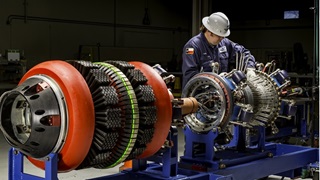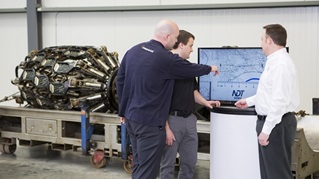Fiber optics and finesse: Leak detection initiative goes deep in Alberta
HDD project under North Saskatchewan River aims to advance pipeline water crossing safety
It is, potentially, a big step forward for pipeline water crossing safety.
You might even say 966 big steps forward.
Last fall, during the construction of our Norlite Pipeline northeast of Edmonton, Alberta, Enbridge’s construction and leak detection crews—along with representatives of Banister Pipelines, Michels Canada and Chemco—collaborated on a technological breakthrough that may one day add another layer of safety in the pipeline industry.
Using a Horizontal Directional Drilling (HDD) procedure—in this case, drilling a parabolic tunnel deep beneath the North Saskatchewan River—crews installed 966 metres, or 0.6 miles, of pipe and fiber optic cable.
That’s more than seven Canadian Football League fields, including end zones—and it’s the longest successful HDD installation, to date, involving a steel pipe and a fiber cable.
Enbridge is involved in an ongoing initiative to validate fiber optic cable’s effectiveness in detecting leaks along our crude oil pipeline routes, particularly sensitive segments such as river crossings.
“River crossings are a real challenge. To be honest, there was a healthy degree of skepticism that we could meet the challenge of placing a sensitive fiber optic cable next to a heavy steel pipe. This feels like a moon shot—and we landed it,” says Ray Philipenko, Manager of the Leak Detection department within Enbridge’s Pipeline Control Systems and Leak Detection (PCSLD) area.
“The complexity is pretty high on a long HDD crossing, even for a steel pipe . . . and there were many ways the fiber or polyethylene conduit could have been damaged deep underground,” says Jim Bazeley, a regional construction and facilities manager for Enbridge’s Major Projects unit. “What we did, ultimately, was validate a lot of the engineering that went into this project.”
During the 40-day HDD project in October 2016, Michels Canada first bored a 36-inch-diameter hole travelling approximately 35 metres (115 feet) under the North Saskatchewan River.
The 24-inch-diameter welded pipeline segment was then pulled back through the underground arched tunnel, using a purpose-built “pull-head” that pulled the polyethylene conduit along with the pipe—and allowed the conduit to snake its way, unconstrained, through the bore hole.
Engineers opted not to strap the polyethylene conduit, manufactured by DuraLine, to the pipe during the pullback procedure to avoid damaging the pipeline’s protective coating and ensure the highest safety standards.
“That allowed our team and our contractors to complete the final pipeline coating verification, and send test signals down the cable to verify the integrity of the fiber optics, as it was being pulled through the bore hole,” says Bazeley.
Remarks Shelley Wiltshire, a PCSLD project manager with Enbridge: “This is the first installation on our system that can support fiber optic-based leak detection systems. We placed two types of fiber optic cable under the river—and they’re right next to the pipe.”
Now that the cable is in place, Enbridge’s leak detection team will embark on the next phase of the project to confirm the reliability of the fiber optic leak detection systems, and the performance of the technologies for HDD river crossings.
“The North Saskatchewan River is a critical asset to the province of Alberta, and to have the extra layer of protection that this technology could provide would be tremendous,” says Philipenko. “It wasn’t easy, but now we know it’s possible—and that’s a very big first step.”
(TOP PHOTO: Crews assist in the pullback process during an HDD procedure on our Norlite Pipeline last fall. The purpose-built "pull head" brought two reinforced strands of fiber optic cable, from the orange spools on either side of the pipe, through a parabolic tunnel travelling about 115 feet under Alberta's North Saskatchewan River. At 966 metres or 0.6 miles—or seven CFL fields, including end zones—it's the longest successful HDD installation, to date, involving steel pipe and a fiber cable.)










